#picual
Text
Buy Spanish Picual Extra Virgin Olive Oil
Indulge in the rich flavors of our Spanish Picual Extra Virgin Olive Oil. Sourced from premium olives, this exquisite oil elevates your culinary creations. Elevate your dishes with the authentic taste and health benefits of this liquid gold. Buy now and savor the essence of Mediterranean excellence.
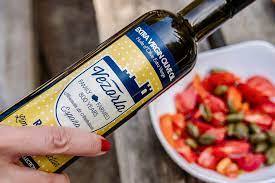
0 notes
Text

PRECIO ACEITE DE OLIVA X LITRO $6.666 pesos #SUPER OFERTA#
PROMOCION COMPRANDO 1 CAJA de 6 Botellas (total 12 litros) y retirando por nuestra oficina en Villa Urquiza. Oferta valida hasta agotar stock de 100 unidades.
NECESITAS ENVIO EN ARGENTINA? COMPRA ACA: https://mercadooliva.com/producto/aceite-de-oliva-extra-virgen-primera-prensada-en-frio/
PRODUCTO: Aceite De Oliva Extra Virgen PRIMERA PRENSADA EN FRÍO Mendoza 6 Botellas De 2 Litros Libre de Gluten – Sin T.A.C.C.
PRIMERA PRENSADA EN FRÍO
Es un Blend de diferentes varietales de aceitunas de primera calidad como Arauco, Arbequina y Picual. Se trata de un excelente Aceite de Oliva Extra Virgen de sabor intenso aceitunado y con un sabor aceitunado único y sabroso. Es ideal para tus ensaladas y todo tipo de comidas. Incluso es perfecto para cocinar y dar ese sabor perfecto a tus recetas.
Marca: San Nicolás Reyes
Tipo: Aceite de Oliva Extra Virgen Primera Prensada en Frío
Procedencia: MENDOZA
Blend de Varietales Arauco, Arbequina y Picual.
Sabor intenso aceitunado.
Libre de Gluten – Sin T.A.C.C.
Acidez: 0.3%
1ra calidad.
No contiene colesterol.
Vencimiento 07/04/2026
VENTAS X MAYOR – CONSÚLTENOS!
#aceiteoliva #AceitedeOliva #mayoristas #mayoristadeaceitedeoliva #MayoristasdeAceitedeOlivaenArgentina #Argentina #Olive #Oil #extraVirgen #VirgenExtra #Aceitunas #Distribuidora #MercadoCentral
#aceiteoliva#AceitedeOliva#mayoristas#mayoristadeaceitedeoliva#MayoristasdeAceitedeOlivaenArgentina#Argentina#Olive#Oil#extraVirgen#VirgenExtra#Aceitunas#Distribuidora#MercadoCentral
1 note
·
View note
Text
Olivenöl: Tipps zur Auswahl und Qualität

Einführung in Olivenöl
Olivenöl, ein Grundnahrungsmittel der mediterranen Küche, hat sich weltweit einen Namen gemacht. Es ist nicht nur ein kulinarisches Highlight, sondern auch ein gesundheitlicher Segen. Doch die Auswahl des richtigen Olivenöls kann eine Herausforderung sein, da es viele verschiedene Sorten und Qualitätsstufen gibt. In diesem Artikel werden wir tief in die Welt des Olivenöls eintauchen und Ihnen wertvolle Tipps zur Auswahl und Beurteilung der Qualität geben.
Wichtige Faktoren bei der Auswahl von Olivenöl
Herkunft und Anbaugebiet
Die Herkunft des Olivenöls spielt eine entscheidende Rolle für seinen Geschmack und seine Qualität. Olivenöle aus verschiedenen Regionen haben unterschiedliche Geschmacksprofile, die durch das Klima, den Boden und die Olivensorte beeinflusst werden. Bekannte Anbaugebiete sind Italien, Spanien, Griechenland und die Türkei. Jedes dieser Länder hat seine eigenen charakteristischen Olivenöle, die es zu entdecken gilt.
Olivensorten
Es gibt Hunderte von Olivensorten, die für die Herstellung von Olivenöl verwendet werden. Jede Sorte hat ihre eigenen einzigartigen Eigenschaften. Einige der bekanntesten Sorten sind Arbequina, Koroneiki, Picual und Frantoio. Die Wahl der Olivensorte beeinflusst den Geschmack, das Aroma und die Farbe des Öls.
Erntezeitpunkt
Der Zeitpunkt der Olivenernte ist ein weiterer wichtiger Faktor. Früh geerntete Oliven ergeben ein Öl mit einem intensiveren Geschmack und höherem Polyphenolgehalt, während spät geerntete Oliven ein milderes und fruchtigeres Öl produzieren. Der Erntezeitpunkt kann auch die Farbe des Öls beeinflussen, wobei früh geerntete Oliven ein grüneres Öl und spät geerntete Oliven ein gelberes Öl ergeben.
Qualitätsmerkmale von Olivenöl verstehen

Säuregehalt
Der Säuregehalt ist ein wichtiger Indikator für die Qualität von Olivenöl. Ein niedriger Säuregehalt weist auf ein hochwertiges Öl hin. Extra natives Olivenöl (Extra Virgin Olive Oil) darf einen Säuregehalt von maximal 0,8% haben. Ein höherer Säuregehalt kann auf minderwertige Oliven oder unsachgemäße Verarbeitung hinweisen.
Polyphenolgehalt
Polyphenole sind natürliche Antioxidantien, die in Olivenöl vorkommen. Sie tragen nicht nur zur Haltbarkeit des Öls bei, sondern haben auch gesundheitliche Vorteile. Ein hoher Polyphenolgehalt ist ein Zeichen für ein hochwertiges Olivenöl. Polyphenole verleihen dem Öl auch einen leicht bitteren und scharfen Geschmack.
Sensorische Eigenschaften
Die sensorischen Eigenschaften eines Olivenöls umfassen Geschmack, Aroma und Farbe. Ein gutes Olivenöl sollte fruchtig, leicht bitter und scharf sein. Diese Eigenschaften sind ein Hinweis auf die Frische und Qualität des Öls. Ein ranziger oder muffiger Geruch deutet auf ein minderwertiges oder verdorbenes Öl hin.
Tipps zum Kauf von hochwertigem Olivenöl
Etiketten und Zertifikate
Beim Kauf von Olivenöl sollten Sie auf das Etikett achten. Begriffe wie "extra nativ" oder "kaltgepresst" sind Indikatoren für Qualität. Zertifikate wie das DOP (Denominazione di Origine Protetta) oder das IGP (Indicazione Geografica Protetta) garantieren, dass das Öl aus einer bestimmten Region stammt und strenge Qualitätskontrollen durchlaufen hat.
Verpackung
Die Verpackung spielt eine wichtige Rolle bei der Erhaltung der Qualität von Olivenöl. Dunkle Glasflaschen oder Edelstahlbehälter schützen das Öl vor Licht und Sauerstoff, die seine Qualität beeinträchtigen können. Vermeiden Sie Plastikflaschen, da sie Chemikalien an das Öl abgeben können.
Preis
Qualität hat ihren Preis. Ein hochwertiges Olivenöl ist selten billig. Wenn der Preis zu gut erscheint, um wahr zu sein, ist es wahrscheinlich, dass das Öl von minderer Qualität ist. Investieren Sie in ein gutes Olivenöl, um den vollen Geschmack und die gesundheitlichen Vorteile zu genießen.
Unterschiede zwischen verschiedenen Olivenölsorten
Extra Natives Olivenöl
Extra natives Olivenöl ist die höchste Qualitätsstufe und wird durch mechanische Verfahren ohne den Einsatz von Chemikalien gewonnen. Es hat einen niedrigen Säuregehalt und einen hohen Polyphenolgehalt. Der Geschmack ist intensiv und fruchtig, oft mit bitteren und scharfen Noten.
Natives Olivenöl
Natives Olivenöl ist ebenfalls von guter Qualität, hat jedoch einen höheren Säuregehalt als extra natives Olivenöl. Es wird ebenfalls mechanisch gewonnen, kann aber leichte Mängel im Geschmack aufweisen. Es ist eine gute Wahl für das tägliche Kochen.
Raffiniertes Olivenöl
Raffiniertes Olivenöl wird chemisch behandelt, um Unreinheiten zu entfernen. Es hat einen neutralen Geschmack und eine helle Farbe. Es wird oft mit nativem Olivenöl gemischt, um "Olivenöl" oder "reines Olivenöl" zu erzeugen. Es ist weniger gesund und geschmacklich weniger interessant als natives oder extra natives Olivenöl.
Lagerung und Haltbarkeit von Olivenöl
Richtige Lagerung
Olivenöl sollte an einem kühlen, dunklen Ort gelagert werden, um seine Qualität zu erhalten. Licht, Wärme und Sauerstoff können das Öl oxidieren und ranzig machen. Eine Temperatur zwischen 15 und 20 Grad Celsius ist ideal. Verwenden Sie dunkle Glasflaschen oder Edelstahlbehälter, um das Öl zu schützen.
Haltbarkeit
Olivenöl hat eine begrenzte Haltbarkeit. Extra natives Olivenöl kann bis zu zwei Jahre haltbar sein, verliert jedoch mit der Zeit an Geschmack und Nährstoffen. Achten Sie auf das Verfallsdatum und verbrauchen Sie das Öl innerhalb von sechs Monaten nach dem Öffnen, um den besten Geschmack zu gewährleisten.
Gesundheitliche Vorteile von Olivenöl

Herzgesundheit
Olivenöl ist reich an einfach ungesättigten Fettsäuren, die das Herz-Kreislauf-System unterstützen. Studien haben gezeigt, dass der regelmäßige Verzehr von Olivenöl das Risiko von Herzkrankheiten senken kann. Die Polyphenole im Olivenöl wirken entzündungshemmend und antioxidativ, was ebenfalls zur Herzgesundheit beiträgt.
Antioxidative Eigenschaften
Die Antioxidantien im Olivenöl, insbesondere die Polyphenole, schützen die Zellen vor Schäden durch freie Radikale. Dies kann das Risiko von chronischen Krankheiten wie Krebs und Alzheimer verringern. Olivenöl kann auch die Hautgesundheit verbessern und vorzeitiger Alterung vorbeugen.
Verdauungsgesundheit
Olivenöl fördert die Verdauung und kann bei der Linderung von Magen-Darm-Beschwerden helfen. Es regt die Produktion von Galle an, was die Fettverdauung unterstützt. Zudem wirkt es leicht abführend und kann bei Verstopfung helfen.
Häufige Missverständnisse über Olivenöl
"Olivenöl ist nicht zum Braten geeignet"
Ein weit verbreitetes Missverständnis ist, dass Olivenöl nicht zum Braten geeignet ist. Tatsächlich hat extra natives Olivenöl einen relativ hohen Rauchpunkt von etwa 190-210 Grad Celsius und kann daher zum Braten verwendet werden. Es ist jedoch wichtig, das Öl nicht zu stark zu erhitzen, um seine gesundheitlichen Vorteile zu erhalten.
"Grünes Olivenöl ist besser als gelbes"
Die Farbe des Olivenöls sagt nichts über seine Qualität aus. Grünes Olivenöl stammt oft von früh geernteten Oliven und hat einen intensiveren Geschmack, während gelbes Olivenöl von reiferen Oliven stammt und milder ist. Beide können von hoher Qualität sein, abhängig von der Verarbeitung und den verwendeten Oliven.
"Teures Olivenöl ist immer besser"
Der Preis ist nicht immer ein zuverlässiger Indikator für die Qualität von Olivenöl. Es gibt viele Faktoren, die den Preis beeinflussen, einschließlich der Produktionsmethoden, der Verpackung und der Marketingkosten. Es ist wichtig, auf die Etiketten und Zertifikate zu achten und das Öl zu probieren, um die Qualität zu beurteilen.
Fazit
Die Auswahl des richtigen Olivenöls erfordert ein gewisses Maß an Wissen und Aufmerksamkeit. Indem Sie die Herkunft, die Olivensorte, den Erntezeitpunkt und die Qualitätsmerkmale berücksichtigen, können Sie ein hochwertiges Olivenöl finden, das Ihren kulinarischen und gesundheitlichen Bedürfnissen entspricht. Achten Sie auf Etiketten und Zertifikate, lagern Sie das Öl richtig und genießen Sie die vielfältigen Vorteile dieses wunderbaren Naturprodukts.
0 notes
Text
What kind of olives yield Extra Virgin Olive Oil?
Extra Virgin Olive Oil (EVOO) is made from the first pressing of olives, and it must meet certain quality standards to be classified as "extra virgin." The type of olives used to produce extra virgin olive oil can vary, as different olive varieties have distinct flavors, aromas, and characteristics. Some common olive varieties used to produce EVOO include:
Arbequina: These olives are small and fruity, often producing oils with a mild and delicate flavor.
Picual: This is a widely cultivated olive variety, particularly in Spain. Picual olives often result in oils with a robust, peppery, and slightly bitter flavor profile.
Hojiblanca: Another prominent Spanish variety, Hojiblanca olives contribute to oils with a fruity and slightly bitter taste.
Koroneiki: Commonly grown in Greece, the Koroneiki olive is known for producing oils with a robust and peppery flavor.
Frantoio: Originating from Italy, Frantoio olives are often used in the production of high-quality olive oils with a balanced and fruity taste.
Leccino: Another Italian variety, Leccino olives are known for producing oils with a mild and fruity profile.
The flavor of extra virgin olive oil is influenced by factors such as the olive variety, climate, soil conditions, and the timing of the harvest. Early-harvest olives tend to produce oils with more robust and peppery characteristics, while late-harvest olives may result in milder oils.
It's worth noting that the term "extra virgin" signifies the highest quality of olive oil, and it is extracted using mechanical means (pressing or centrifugation) without the use of heat or chemicals. Additionally, the oil must meet specific chemical and sensory criteria, including low acidity and a favorable taste profile, to be classified as extra virgin.
0 notes
Text
Azeite Prosperato lança edição comemorativa
Marca faz 10 anos com novo produto
Marca faz 10 anos com novo produto
A Azeite Prosperato está completando 10 anos de atividade e, para celebrar o marco, lança um rótulo especial: o Prosperato Origens: Campanha Gaúcha.
O produto é um azeite do tipo Assemblage, criado pelo diretor e mestre de lagar da empresa, Rafael Marchetti. O lançamento combina as variedades Koroneiki, da Grécia; e Picual, da Espanha.
O lançamento foi feito…

View On WordPress
0 notes
Text
Mancha Oliva
En el corazón de La Mancha, en el año 1921, se fundó la Almazara "MEL" y su Aceite de Oliva Virgen Extra fue reconocido en Tarancón y comarca; desde entonces y hasta nuestros días hemos ido agrupando conocimientos y experiencia como maestros aceiteros, sin dejar a un lado nuestra tradición pero con la más alta tecnología, consiguiendo extendernos por todo el territorio nacional gracias a la calidad de nuestros productos
Dirección:Ctra. Tarancón—Villamayor KM 33.400 (Cuenca)
0 notes
Text
Ubeda, Spain
August 12-14 2023
After having our minds blown in Cordeba, we headed to Ubeda - a tiny village located in the "Mer de Olives" - the sea of olives. Spain has 300 MILLION plus olive trees and I'm not kidding. One can travel miles and miles and miles and see only olive groves.



We are in the region (think “state”) of Andalusia and we have been here for most of our time in Spain, so far.

Úbeda is a municipality of Spain of 35,000 people located in the region of Andalusia. The town lies on the southern ridge of the Sierra Nevada's so-called Loma de Úbeda, a table sandwiched in between the Guadalquivir and the Guadalimar river beds.
The Parador de Úbeda was the first palace converted into a Parador in Spain in 1910 and is located in a former palace which belonged to the dean of the Sacred chapel of El Salvador. It was built in the 16th century and altered in the 17th century. It is beautiful.


Our room:


And the view from both our balconies:

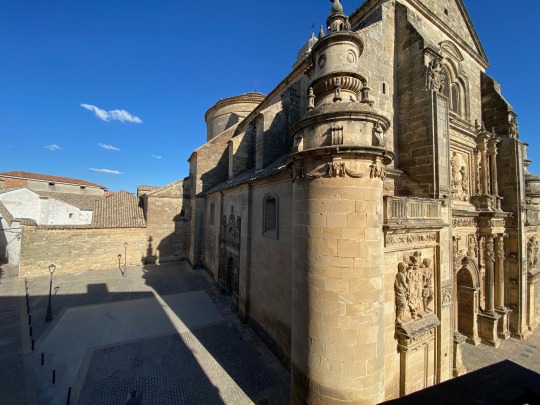
The beautiful Church of San Salvador! The photo below shows are parador to the left of the church and in the shade. Our room is in the upper corner by the church.
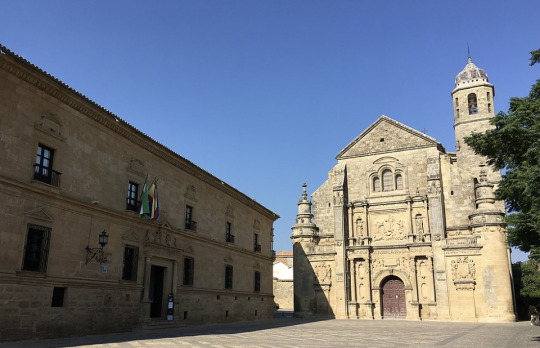
From the website:
The building, of Renaissance architecture, stands out for its façade and the splendid central patio, one of the most beautiful in Úbeda. The large windows on the façade flood the interior with light, where the elegant rooms and majestic halls are fully equipped for holding meetings and events.
Úbeda was declared a World Heritage City for its Renaissance monumental complex. A walk through its historic center explains this title granted by the heritage and historical wealth found in its streets, palaces, churches and museums. The city is also rich in crafts, gastronomy and Andalusian folklore. The title is shared with the city of Baeza, also notable for its Renaissance monumental complex and located a few kilometers from Úbeda.
The Parador Ubeda is the former palace of Don Fernando Ortega Salido. Originally a Moorish palace – he had it rebuilt to his liking – then had the chapel built right next to it. Hemingway, Pio Baroja, Garcia Lorca, and Paul Bowles have all stayed here at the Parador, so it has attracted a particularly literary crowd!
We took a little walk around the place town and then had dinner and went to bed. We had a big day the next day exploring the olive oil process. This begins with us going into the groves and picking the olives.
Below is Ken, olive gatherer extraordinaire, holding his high tech olive harvesting tool and his trusted assistant, Judith.
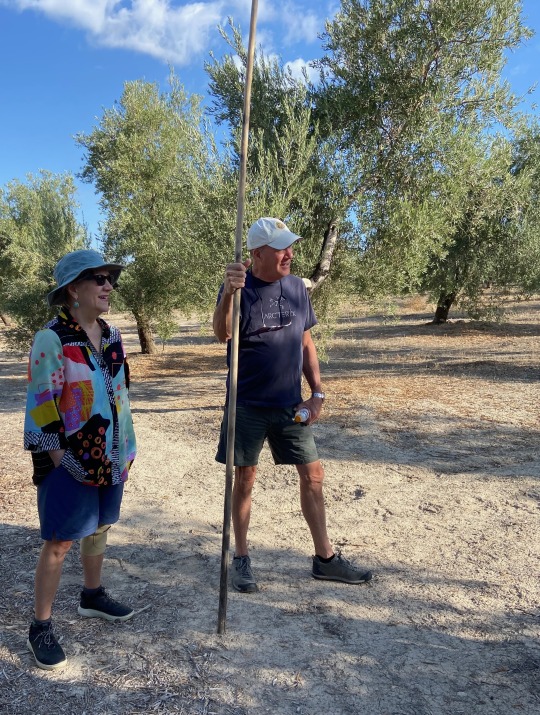
Next lay out the net...
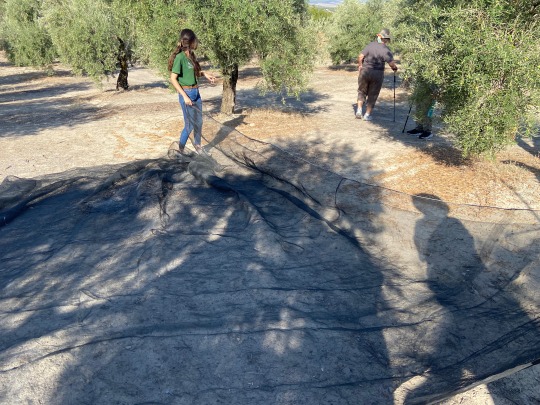
And get some instructions on what to do and what to pick and not pick...
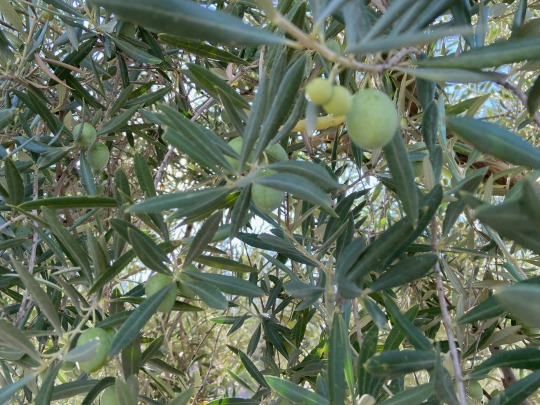
Then the "combing" begins...

Lots of people used the high tech tool - but Mark just used the walking sticks - Amateur!

Lots of people got into the action and we got a pretty good crop. Then we gathered up our olives

And I snapped this. I have entitled it "Spanish Gothic"

We also visited an olive tree that was 200 years old and still producing olives. I'm impressed!

This might look - to the untrained eye - liike it is 4 trees - but nope - one root. Next step - take the booty to the factory to turn those olive into olive oil.

George is the designated "pourer" and the process begins. We didn't just go so some ol' olive oil producer, we visited the producer that won the grand prize for the best Olive Oil for 2023, Oleícola San Francisco Olive Oil Factory.

We learned that a black olive and a green olive are the same - just in different stages of ripening. The are more than 700 varieties of olives but we picked Picual Olives. There are only three types of olive oil - 1. Extra Virgin. 2. Virgin and 3 Lambaste (DO NOT EAT THIS!!). Extra Virgin must be perfect in lots of categories and have no chemical and process with no heat. Virgin is just not quite Extra Virgin and the last is used for lots of things - but is low quality and should not be eaten. I wrote "should" because while it is illegal to sell for consumption in the EU - it is not illegal in the lots of other places - like the US. If the bottle says "Olive Oil" you are getting Lambaste. Or CRAP! We also learned they harvest from October to January - but depending on weather it may be September to February. They went through every step which was fascinating - BUT I found this YouTube that can tell you much better than I can. Two things... She begins the video right outside our parador AND she doesn't know that in Spain - you do NOT say "hasta la vista" (as in the Terminator.). I'm sure you say many other farewell greetings - but all I can think of now is "Adios." But despite those things - this video is great!
youtube
After the process was explained to us - we tasted some oil, (spoiler alert - the one in the blue glass is the best in the world.)

Next, we went to work making lunch. It was so much fun!
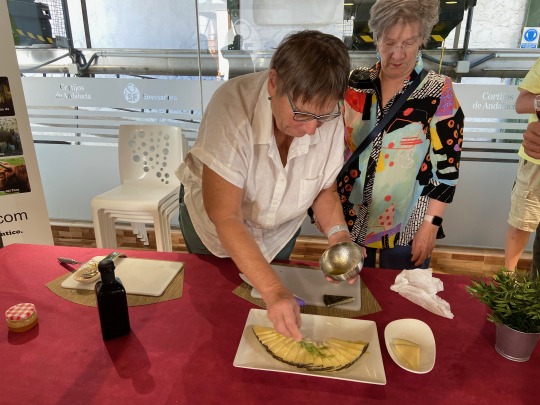
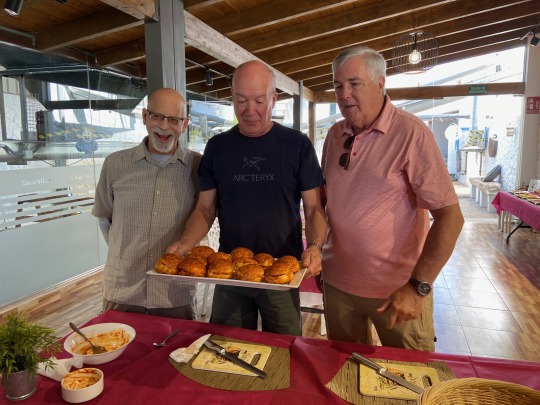
We made a delicious salad - but I took no pics of that. :(

Lunch was great and then with our newly found knowledge and some olive oil, we headed back to Ubeda. After our seista - i could get real use to this - FYI - we took a nice walk around the city stopping at a a potters shop who is bringing back pottery of the past - like this birthing pot.

The midwife is there to catch the baby - but this cuts down on the mess. Used centuries ago - this potter is bringing back the vessel. I'll get back you on how I feel about this.
We continued our walk until Carolina had another edible discovery, churros and hot chocolate. Both the churros and hot chocolate were different for the things we know in the states.


The churros in the US are covered with cinnamon and sugar - but not here. The hot chocolate here is like a warm chocolate pudding. I heard rave review.
For dinner, Joe, Daphne, Mark and I did a supermarket run and did wine, cheese and jamon in the room. We didn't START in the room, we started in the courtyard after I made sure it was OK - but then - when we were almost done - the guy who told me it was OK - came toward us waving his hands - saying "FORBIDDEN!!! No big deal - be packed up and went to our room. You can't scare us!
Ubeda was a wonderful place and we loved our time there - but tomorrow we leave for Toledo.
We are loving Spain.
Stay tuned.
0 notes
Text
Olive Oil Arab: Exploring the Richness of Arab Olive Oil
Introduction
Olive oil has been an integral part of Arab culture for centuries, deeply rooted in tradition and cherished for its numerous benefits. Arab regions boast a rich history of olive cultivation and oil production, with distinct flavors and aromas that set them apart. In this article, we will delve into the world of Olive Oil Arab, exploring its history, production process, health benefits, culinary uses, skincare applications, economic significance, and more. So grab a bottle of Olive Oil Arab and join us on this flavorful journey.
1. The History of Olive Oil in Arab Culture
Olive oil Arab holds significant cultural importance in Arab traditions, dating back thousands of years. Its origins can be traced to ancient civilizations such as the Phoenicians and Egyptians. Arab regions, with their favorable climate and fertile lands, became ideal for olive cultivation. The olive tree became a symbol of prosperity, peace, and purity in Arab culture, and its oil was highly valued for its versatility and health benefits.
2. The Olive Varieties in Arab Regions
Arab regions are home to a wide variety of olives, each contributing to the unique flavors and characteristics of Olive Oil Arab. Some of the popular olive varieties include:
Manzanilla
Nabali
Souri
Chemlali
Picual
Barnea
Each variety possesses distinct taste profiles, ranging from fruity and mild to robust and peppery. The careful selection and blending of these olives during the production process result in a wide range of flavors to suit different palates.
3. The Production Process of Arab Olive Oil
The production process of Olive Oil Arab is steeped in tradition, emphasizing quality and authenticity. It involves several key steps, including:
Harvesting
Olive trees are carefully tended, and the olives are harvested at the optimal stage of ripeness. Traditional methods involve handpicking, ensuring that only the best olives are chosen for oil extraction.
Pressing and Extraction
The freshly harvested olives are washed and then crushed to create a paste. This paste is then pressed to extract the precious olive oil. The traditional method of cold pressing ensures minimal heat is generated, preserving the oil's natural flavors and nutrients.
Filtration and Bottling
After extraction, the oil undergoes filtration to remove any impurities, ensuring clarity and purity. It is then carefully bottled to protect its freshness and quality.
4. Health Benefits of Olive Oil Arab
Olive Oil Arab offers a multitude of health benefits, making it a staple in many diets. Some notable advantages include:
Rich in Antioxidants
Olive Oil Arab is rich in antioxidants, such as vitamin E and polyphenols, which help protect the body against oxidative stress and inflammation.
Heart-Healthy Properties
Regular consumption of Olive Oil Arab has been linked to a reduced risk of heart disease due to its high content of monounsaturated fats, which can help lower bad cholesterol levels.
Anti-Inflammatory Effects
The anti-inflammatory properties of Olive Oil Arab can aid in reducing inflammation within the body and potentially alleviate symptoms of chronic diseases.
Digestive Health
Olive Oil Arab has been known to promote healthy digestion and aid in the absorption of essential nutrients.
5. Culinary Uses of Olive Oil Arab
Olive Oil Arab is a prized ingredient in Arab cuisine, adding depth and flavor to a wide range of dishes. Here are some popular culinary uses:
Salad Dressings and Dips
The smooth and fruity notes of Olive Oil Arab make it an excellent choice for creating delicious salad dressings, marinades, and flavorful dips like hummus and baba ganoush.
Sautéing and Frying
The high smoke point of Olive Oil Arab makes it suitable for sautéing and frying, imparting a delicate taste to vegetables, meats, and seafood.
Baking and Desserts
In baking, Olive Oil Arab can be used as a healthier alternative to butter, adding moisture and a subtle fruitiness to cakes, cookies, and pastries.
6. Beauty and Skincare Benefits of Olive Oil Arab
Apart from its culinary uses, Olive Oil Arab offers various beauty and skincare benefits. Its natural properties make it a versatile ingredient for nourishing the skin and hair. Some benefits include:
Moisturization and Nourishment
Olive Oil Arab contains essential fatty acids and vitamins that deeply moisturize and nourish the skin, promoting a healthy complexion.
Makeup Remover
Gently removing makeup is made easier with Olive Oil Arab. Its gentle yet effective cleansing properties make it suitable for all skin types.
Hair Conditioning
Applying Olive Oil Arab to the hair can help improve shine, manageability, and reduce frizz. It also provides nourishment to the scalp, promoting healthier hair growth.
7. The Economic Importance of Olive Oil Arab
Olive Oil Arab holds significant economic importance in the Arab region, contributing to both domestic and international markets. It supports the livelihoods of numerous farmers, producers, and exporters, playing a vital role in the local economies. The demand for high-quality Olive Oil Arab continues to grow globally, further boosting the industry's economic significance.
8. Sustainability and Environmental Impact
The cultivation and production of Olive Oil Arab emphasize sustainable practices, ensuring the preservation of natural resources and the environment. Traditional farming methods, such as terracing and dry farming, minimize water usage and soil erosion. Additionally, many producers prioritize organic farming techniques, reducing the use of pesticides and promoting biodiversity.
9. Popular Brands of Olive Oil Arab
When exploring Olive Oil Arab, it's worth considering some of the popular and reputable brands available. These brands prioritize quality and authenticity, offering a wide range of flavors and characteristics to suit different preferences. Some well-known brands include:
Al Wadi Al Akhdar
Zaituna
Al Badawi
Ode to Olive
Jordan Farms
10. Tips for Choosing and Storing Olive Oil Arab
To ensure you select the best Olive Oil Arab and preserve its freshness, consider the following tips:
Look for certifications and labels indicating authenticity and quality.
Opt for dark glass bottles to protect the oil from light and maintain its flavors.
Store Olive Oil Arab in a cool, dark place away from direct sunlight and heat sources.
Use the oil within its recommended shelf life to enjoy its optimal taste and nutritional benefits.
11. How to Incorporate Olive Oil Arab into Your Daily Life
Incorporating Olive Oil Arab into your daily routine is simple and rewarding. Here are some ideas to get you started:
Drizzle Olive Oil Arab over salads, roasted vegetables, or grilled meats for a burst of flavor.
Use it as a finishing oil to enhance the taste of soups, stews, and pasta dishes.
Create a homemade facial or hair mask by combining Olive Oil Arab with natural ingredients like honey, yogurt, or avocado.
Substitute Olive Oil Arab for butter or other oils in your favorite baking recipes for a healthier twist.
12. Myths and Misconceptions About Olive Oil Arab
There are several myths and misconceptions surrounding Olive Oil Arab. Let's debunk some of the common ones:
Myth: All Olive Oil Arab tastes the same.
In reality, Olive Oil Arab comes in various flavors and characteristics, depending on the olive varieties used, the production methods, and the region of origin.
Myth: Olive Oil Arab cannot be used for frying.
Contrary to this belief, Olive Oil Arab has a high smoke point, making it suitable for frying and sautéing at moderate temperatures.
Myth: Olive Oil Arab loses its health benefits when heated.
While excessive heat can degrade the quality of any oil, Olive Oil Arab retains many of its health benefits when used in cooking, thanks to its high content of monounsaturated fats and antioxidants.
13. Olive Oil Arab in the Global Market
Olive Oil Arab has gained recognition and popularity in the global market. Its unique flavors, cultural heritage, and health benefits have made it a sought-after culinary and wellness ingredient worldwide. The demand for Olive Oil Arab continues to grow, providing economic opportunities and promoting cultural exchange.
Conclusion
Olive Oil Arab is more than just a culinary staple. It represents the rich heritage, cultural significance, and health-promoting properties of Arab regions. From its historical roots to its versatile applications in cooking, skincare, and beyond, Olive Oil Arab invites us to embrace its flavors and benefits. So, next time you reach for a bottle of olive oil, consider exploring the diverse and vibrant world of Olive Oil Arab.
Frequently Asked Questions (FAQs)
Q1. Can Olive Oil Arab be used for deep frying?
Yes, Olive Oil Arab can be used for shallow frying and deep frying due to its high smoke point and stability at high temperatures. However, it is recommended to use it in moderation and follow proper frying techniques.
Q2. How long does Olive Oil Arab last?
The shelf life of Olive Oil Arab can vary depending on factors such as the quality of the oil and how it is stored. On average, it can last up to two years when stored properly in a cool, dark place.
Q3. Is Olive Oil Arab suitable for all skin types?
Yes, Olive Oil Arab is generally suitable for all skin types. However, individuals with specific skin concerns or allergies should perform a patch test before using it extensively.
Q4. What makes Olive Oil Arab different from other types of olive oil?
Olive Oil Arab is distinguished by its unique flavors, which are influenced by the specific olive varieties grown in Arab regions and the traditional production methods employed. It offers a diverse range of taste profiles, setting it apart from other olive oils.
Q5. Where can I purchase authentic Olive Oil Arab?
Authentic Olive Oil Arab can be purchased from specialty stores, local markets in Arab regions, or reputable online retailers. Look for certifications and labels that guarantee the authenticity and quality of the product
0 notes
Link
0 notes
Text
Buy Spanish Picual Extra Virgin Olive Oil
Indulge in the rich flavors of our Spanish Picual Extra Virgin Olive Oil. Sourced from premium olives, this exquisite oil elevates your culinary creations. Elevate your dishes with the authentic taste and health benefits of this liquid gold. Buy now and savor the essence of Mediterranean excellence.
0 notes
Text

Para la bienvenida a Jeanne, en el desayuno hemos puesto tostadas de tomate en pan de centeno con nueces y pasas, con aceite pintarré de aceituna picual sin filtrar, y sal marina nodoguro, exclusiva incluso en Japón. Café con miel cremosa, y leche de soja. En la mesa, aceitunas chupadedos, ciruelas, y las mandarinas verdes del huerto de mi Madrina, que son una apoteosis de sabor. ¡Pero qué cosa!
Comida ¡Fuuu-sión!

1 note
·
View note
Photo
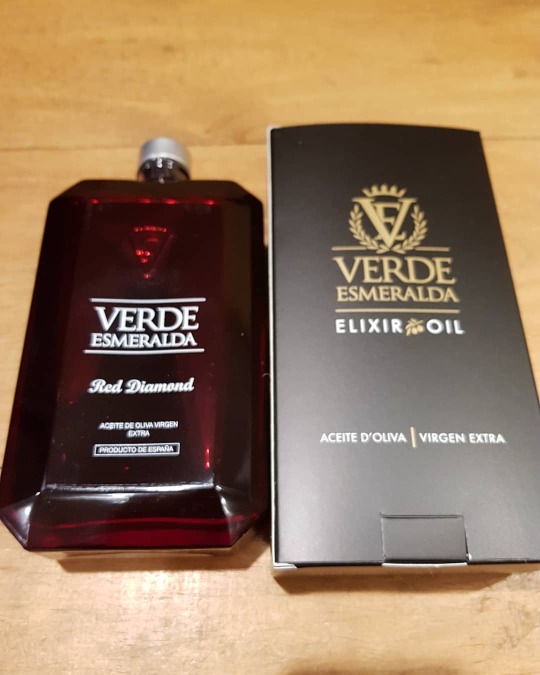
El Aceite de Oliva Virgen Extra de la marca Verde Esmeralda en su variedad Red Diamond elaborado a partir de la aceituna Royal es el hermano mayor de el otro AOVE que produce la Marca Verde Esmeralda. Red Diamond se caracteriza por un sabor mas intenso otorgado por la variedad de aceituna Royal utilizada para su elaboracion. Puede adquirir el Aceite de Oliva Verde Esmeralda Red Diamond en nuestra tienda Gourmet de Denia. https://gourmet-point.com/inicio/verde-esmeralda-red-diamond-royal- #aove #gourmet #dénia #delicatessen #aceiteverde #valencia #aceitedeoliva #alicante #royal #aceitedeolivavirgenextra #regalosgourmet #picual #regalodalicatessen #mejorcalidad #costablanca (en Gourmet Point) https://www.instagram.com/p/CPHxT7fDKBS/?utm_medium=tumblr
#aove#gourmet#dénia#delicatessen#aceiteverde#valencia#aceitedeoliva#alicante#royal#aceitedeolivavirgenextra#regalosgourmet#picual#regalodalicatessen#mejorcalidad#costablanca
1 note
·
View note
Video
instagram
@alentejana.nata のパォン🥖 まずはそのまま🥖 かじって 味わう😆💖 そして次にポルトガル🇵🇹の美味しいお塩とオリーブオイルと共に〜😋💖 #オリーブオイル#メルガレホ #ピクアル #エキストラバージンオリーブオイル #エクストラバージンオリーブオイル #オリーブオイルソムリエ #ヒグロック #パォン (ポルトガ���の#パン 🥖) #oliveoil #oliveoilsommelier #evoo#aove #extravirginoliveoil #olioextraverginedioliva #picual Thanks so much ‼️ @alentejana.nata @kaolylovinson @melgarejoextravirgin @melgarejo_japan https://www.instagram.com/reel/COMsUZzAp0_/?igshid=18gb70iwxqe88
#オリーブオイル#メルガレホ#ピクアル#エキストラバージンオリーブオイル#エクストラバージンオリーブオイル#オリーブオイルソムリエ#ヒグロック#パォン#パン#oliveoil#oliveoilsommelier#evoo#aove#extravirginoliveoil#olioextraverginedioliva#picual
1 note
·
View note
Text
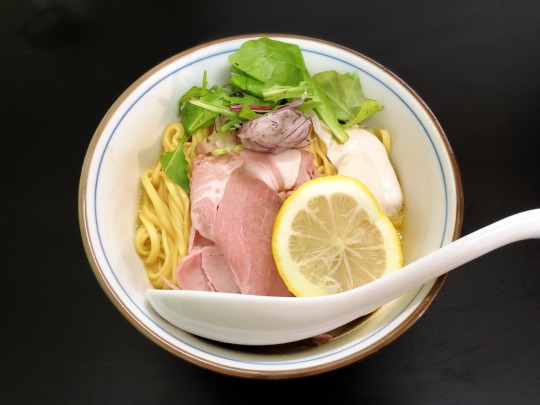
中華そば 四つ葉@西武池袋本店(OLIVE JAPAN 2019)「メルガレホのクリームまぜそば」
2019年30杯目
#ラーメン#まぜそば#メルガレホ#melgarejo#picual#ramen#japan#japanesefood#ramennoodles#foodpics#ラーメン女子#OLIVEJAPAN#OLIVEJAPAN2019
14 notes
·
View notes
Photo

This extra virgin olive oil gifted from @1836oliveco makes everything taste so much better! 🍜 especially #stirfry!!! I think this is the best #oliveoil I've ever tried 🙆 No wonder it's loved by #chefs and sought after by luxury food boutiques. It tastes incredibly fresh and is grown in Asherton, Texas from #Arbequina, #Mission, #Picual and #Tosca olives. Try it for yourself and let me know what you think ➡ https://1836oliveco.com/ . . . . . . . . . . ❤ #momblog #review #westayinspireddaily #organizedmom #organizedhome #reviewer #productreview #ourdailylifestyleEE #influencer #honestreview #momlifeisthebestlife#momsbehappy #parentingblogger #mommyblogger#momblog #californiablogger #mytruelifeinpix #subscriptionbox #subscriptionboxreview #thisisourcandidlife (at California) https://www.instagram.com/p/B7b27oCAP8o/?igshid=1fpaplms73u6y
#stirfry#oliveoil#chefs#arbequina#mission#picual#tosca#momblog#review#westayinspireddaily#organizedmom#organizedhome#reviewer#productreview#ourdailylifestyleee#influencer#honestreview#momlifeisthebestlife#momsbehappy#parentingblogger#mommyblogger#californiablogger#mytruelifeinpix#subscriptionbox#subscriptionboxreview#thisisourcandidlife
1 note
·
View note
Text
Mancha Oliva
En el corazón de La Mancha, en el año 1921, se fundó la Almazara "MEL" y su Aceite de Oliva Virgen Extra fue reconocido en Tarancón y comarca; desde entonces y hasta nuestros días hemos ido agrupando conocimientos y experiencia como maestros aceiteros, sin dejar a un lado nuestra tradición pero con la más alta tecnología, consiguiendo extendernos por todo el territorio nacional gracias a la calidad de nuestros productos.
0 notes